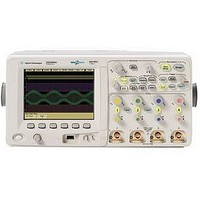DSO5014A AGILENT TECHNOLOGIES, DSO5014A Datasheet - Page 5

DSO5014A
Manufacturer Part Number
DSO5014A
Description
OSCILLOSCOPE, 100MHZ, 4 CHANNEL, 2GSPS
Manufacturer
AGILENT TECHNOLOGIES
Datasheet
1.DSO5012A.pdf
(23 pages)
Specifications of DSO5014A
Scope Type
Digital
Scope Channels
4 Analog
Bandwidth
100MHz
Meter Display Type
TFT-LCD Color
Sampling Rate
2GSPS
Input Impedance
1Mohm
Rise Time
3.5ns
Input Voltage
400V P-p
Lead Free Status / RoHS Status
na
Why does a fast update rate matter?
If the human eye has trouble
discerning above 30-50 frames per
second, is there really a difference
between 3,600 and 100,000
waveforms per second? If you know
what you’re looking for, the answer
is probably “no.” However, if you are
hunting for unknown signal anomalies
or characterizing jitter, the answer
is “yes.”
Figure 3. Reducing the dead time between
acquisitions …
Figure 4. … improves your chances of
finding random events like glitches
Catch problems sooner and cover more of your debug checklist – our 100,000
waveforms per second update rate helps you find intermittent problems up to
100x faster than competitive scopes
Acquisition time
Dead time
Acquisition time
Dead time
If you know that there is a glitch in
your system, it’s easy to capture it
using a pulse-width trigger. However,
if you are just browsing through your
design, your chances of finding a glitch
increase as the oscilloscope’s update
rate increases. If a glitch occurs during
the "dead time" between samples,
you miss it (Figure 3). With MegaZoom
III technology, the dead time is much
smaller (Figure 5). A scope with a
slower update rate will capture the
glitch eventually (if it recurs), but most
engineers and technicians don’t have
the time or patience to wait for their
tools to catch up.
Figure 5. Update rates of popular oscilloscopes using their default real-time
acquisition mode
100,000
10,000
1,000
100
10
ns/div
1
ns/div
10
5000 Series
ns/div
100
Time Base
TDS3000B
If you are characterizing signal jitter,
a fast update rate gives you accurate
results sooner. And when the fast
update rate is combined with the 5000
Series’ XGA high-definition display
(1024 x 768, 256 intensity levels),
subtle differences in these acquisitions
become obvious.
And like all other aspects of
MegaZoom III technology, this update
rate is delivered as a default real-time
acquisition mode. It’s always fast,
always on.
µs/div
1
WaveSurfer 400
µs/div
10
µs/div
5
100










